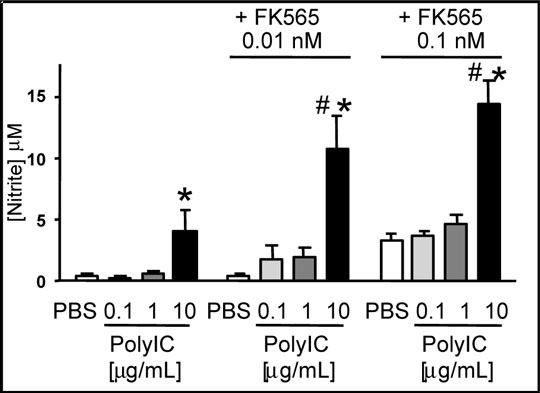Print version
Search Pub Med
Interactions between NOD1 and TLR3 ligands for induction of NOSII activity in vascular smooth muscle cells Vascular smooth muscle cells (VSMC) sense pathogens and danger signals directly which contribute to the development of septic shock and atherosclerosis. We have recently shown that the pattern recognition receptor (PRR) NOD1 plays a key role in the induction of nitric oxide synthase (NOS) II activity by Gram negative bacteria in VSM cells (Moreno et al., 2007). In some cells, maximal response of NOD1 requires an amplification mechanism with, for example, toll-like receptor (TLR) activation. In the current study, we have investigated the effects of bacterial (NOD1, TLR4) and viral (TLR3) PRR stimulation on the induction of NOSII activity in rat VSMC. Rat VSMC were cultured using standard techniques in a humidified incubator at 37°C, 5% CO2 and 95% air. VSMC were stimulated with lipopolysaccharide (LPS; TLR4 agonist), FK565 (NOD1 agonist) and the synthetic analogue of viral dsRNA poly IC (TLR3 agonist) for 48 hours before NOSII activity was assessed by the accumulation of nitrite using the Griess reaction.
Figure 1: Effect of activation of TLR3 with Poly IC or NOD1 with FK565 on NO production by VSMC. Data is the mean±S.E.M. of n = 9.Within group analysis was performed using one-way anova followed by Dunnett’s post-tests.*P<0.05 compared to respective PBS control. Between group analysis was performed using two-way ANOVA followed by Bonferroni post-tests. #P<0.05 compared to responses in absence of FK565
Activation of cells with FK565 or Poly IC alone induced NOSII activity (Figure 1). NOSII activity was enhanced when cells were co-treated with Poly IC plus FK565 (Figure 1). By contrast to results with Poly IC, NOSII activity was not enhanced when cells were treated with LPS and FK565 (P>0.5). These findings suggest a functional cooperation between NOD1 and TLR3 for the induction of NOSII activity in VSMC which may have clinical relevance since both Gram negative bacteria and virus have been proposed as initiators of the local inflammatory response seen in atherogenesis.
Moreno et al., 2007. Proceedings of the British Pharmacological Society at http://www.pA2online.org/abstracts/Vol5Issue2abst037P.pdf
|
|


